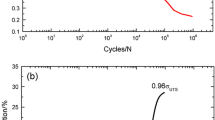Abstract
The mechanical properties of aluminum-graphite composites were measured at room temperature in the as-received condition, after elevated temperature exposure and after thermal cycling. The composites were fabricated by solid-state diffusion bonding of liquid-phase Al-infiltrated Thornel 50 fibers. The results showed that the maximum longitudinal tensile strength of the as-received material was 80,000 psi (552 MN/m2), which corresponds well with the rule of mixture value. The composite strength was observed to vary widely, depending on the extent of wetting of the fibers by the aluminum. The strength of the composites in the transverse direction was generally very low, due to poor interfacial bonding. Aluminum carbide (A14C3) formed at the surface of the fibers at temperatures greater than 500‡C (773 K). Development of the carbide was shown to be diffusion-controlled and was dependent on the time and temperature used. It was shown that the tensile strength was virtually unaffected by heat-treatment up to 500‡C (773 K); beyond that temperature a drastic degradation of tensile strength occurred. The degradation could be correlated with the extent of carbide development at the interface. Thermal cycling of the composites below 500‡C (773 K) resulted in an observable degradation of the composite strength. Scanning electron microscopy of fractured surfaces indicated that the relatively weak interface governs the mode of failure in tension.
Similar content being viewed by others
References
A. A. Baker, C. Shipman, and P. W. Jackson:Fibre Sci. Tech., 1972, vol. 5, p. 213.
P. W. Jackson, D. M. Braddick, and P. J. Walker:Fibre Sci. Tech., 1972, vol. 5, p. 219.
W. C. Harrigan, Jr. and W. W. French: ATR-75(9450)-2, Aerospace Corp., El Segundo, Calif., March 10, 1975.
R. T. Pepper and R. A. Penty:J. Compos. Mater., 1974, vol. 8, p. 29.
W. C. Harrigan, Jr. and D. M. Goddard:J. of Metals, May 1975, p. 20.
A. Morris:Int. Conf. on Carbon Fibres, their Composites and Applications, paper No. 17, London, 1971.
J. Cook and J. E. Gordon:Proc. Roy. Soc., 1964, vol. A282, p. 508.
A. G. Metcalfe:J. Compos. Mater., 1967, vol. 1, p. 356.
A. Pattnaik and A. Lawley:Met. Trans., 1974, vol. 5, p. 111.
W. H. Sutton and E. Feingold: G.E. Space Sci. Lab., Rep. R65SD39, p. 54, 1965.
Y. Umakoski, K. Nakai, and T. Yemane:Met. Trans., 1974, vol. 5, p. 1250.
W. C. Harrigan, Jr.: Aerospace Corporation Tech. Report TR-0075(9250-03)-l, July 31, 1974.
R. T. Pepper, J. W. Upp, R. C. Rossi, and E. G. Kendall:Met. Trans., 1971, vol. 2, p. 117.
Author information
Authors and Affiliations
Rights and permissions
About this article
Cite this article
Khan, I.H. The effect of thermal exposure on the mechanical properties of aluminum-graphite composites. Metall Trans A 7, 1281–1289 (1976). https://doi.org/10.1007/BF02658812
Received:
Issue Date:
DOI: https://doi.org/10.1007/BF02658812




